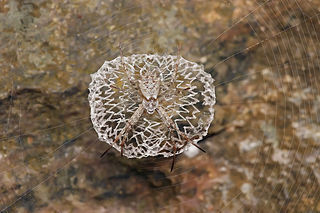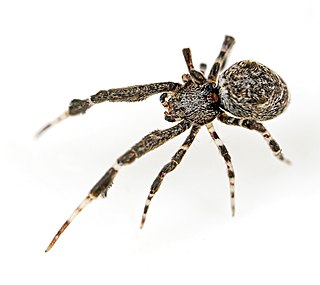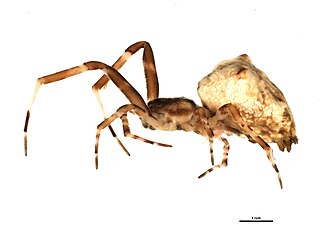
Uloboridae is a family of non-venomous spiders, known as cribellate orb weavers or hackled orb weavers. Their lack of venom glands is a secondarily evolved trait. Instead, they wrap their prey thoroughly in silk, cover it in regurgitated digestive enzymes, and then ingest the liquified body.

Tord Tamerlan Teodor Thorell was a Swedish arachnologist.

A web decoration or stabilimentum is a conspicuous silk structure included in the webs of some species of orb-web spider. Its function is a subject of debate.

Araneus is a genus of common orb-weaving spiders. It includes about 650 species, among which are the European garden spider and the barn spider. The genus was erected by Carl Alexander Clerck in 1757.

Uloborus walckenaerius is a spider in the family Uloboridae. Like all spiders in this family, they do not have venom glands and immobilize their prey with over 140 metres of thread.

Uloborus is a spider genus in the family Uloboridae with 72 described species. Most species occur in the tropics and subtropics, with only few species in northern America and Europe.

Uloborus plumipes is a species of Old World cribellate spider in the family Uloboridae. Common names include the feather-legged lace weaver and the garden centre spider, the latter name being due to its frequent occurrence of this spider in garden centres on the world. The species name is derived from the Latin pluma "feather" and pes "foot".

Spiders are air-breathing arthropods that have eight legs, chelicerae with fangs generally able to inject venom, and spinnerets that extrude silk. They are the largest order of arachnids and rank seventh in total species diversity among all orders of organisms. Spiders are found worldwide on every continent except for Antarctica, and have become established in nearly every habitat with the exceptions of air and sea colonization. As of July 2019, at least 48,200 spider species, and 120 families have been recorded by taxonomists. However, there has been dissension within the scientific community as to how all these families should be classified, as evidenced by the over 20 different classifications that have been proposed since 1900.
Uloborus georgicus is a spider species found in Georgia.
Uloborus gilvus is a spider species found in Italy and Greece.
Uloborus pseudacanthus is a spider species found in Portugal.

Uloborus glomosus is a species of spider in the family Uloboridae. It is one of only a few Uloborus species found in North America and the only species found in Canada. Like all other species in the Uloboridae, Uloborus glomosus does not possess venom glands, relying instead on cribellate, a fuzzy non sticky silk that they use to trap and then wrap their prey. This species exhibits different disturbance behaviors depending on whether there are eggsacs present. If present the female spider will jerk at the web and if not present, then the female spider will walk to the opposite side of the web.
Philoponella congregabilis, sometimes referred to as the little humped spider, is an Australian species of communal spider that, like other species of Uloboridae, does not use venom. Instead it wraps its prey in spider silk to crush it to death. The spider then goes on to regurgitate digestive fluid into the shroud, then consuming the pre-digested liquid. The specific name congregabilis translates to "community dwellers". The generic name Philoponella alludes to their industrious nature, "loving labour".
Uloborus rufus is a species of spiders of the family Uloboridae. It is endemic in Cape Verde. The species was named and described by Günter E. W. Schmidt and Rolf Harald Krause in 1995.
Uloborus campestratus is a species of cribellate orb weaver in the spider family Uloboridae. It is found in a range from the United States to Venezuela.

Uloborus diversus is a species of cribellate orb weaver in the spider family Uloboridae. It is found in the United States and Mexico.
Uloborus canus is a species of spider in the family Uloboridae, found in Australia. The species was first described by W.S. Macleay in 1827. His very brief description said it had a convex white thorax, the first and second legs were equal in length, and the femora were black-spotted. The type specimen has been lost.








